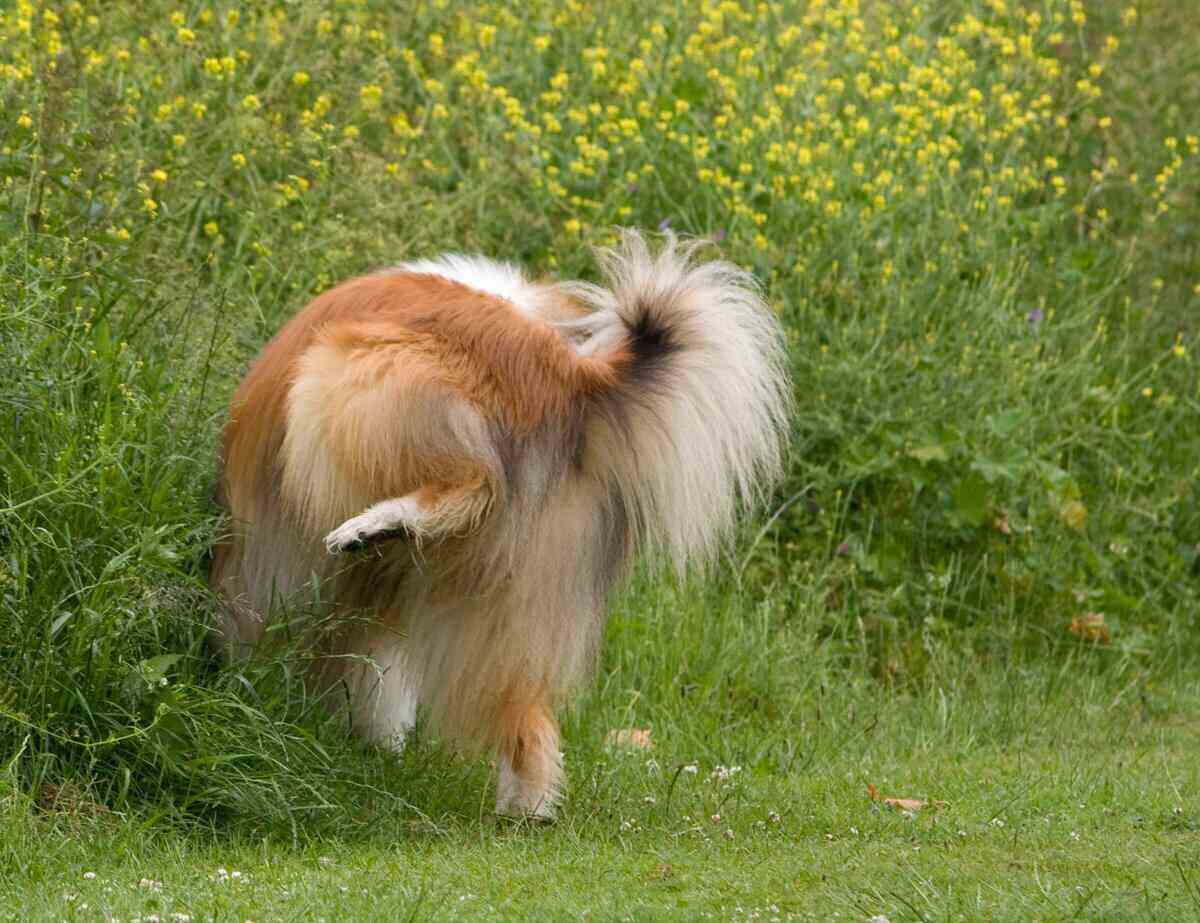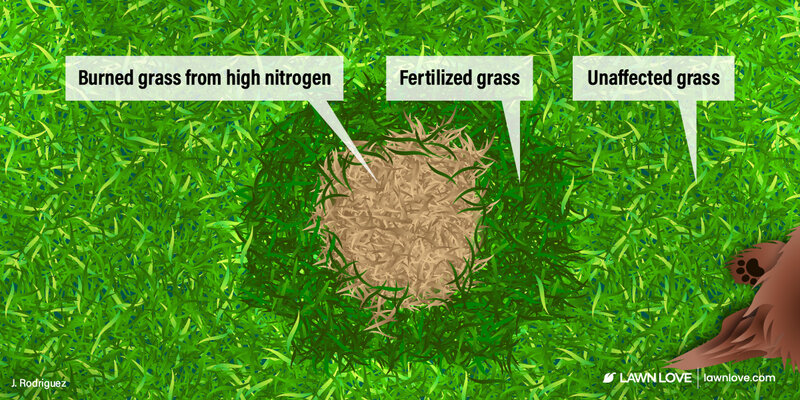
Yes, your precious pup’s pee can kill your grass — if you let it. But if you understand why dog pee kills grass and how to stop it, you can prevent damage to your lawn or repair what’s already been done.
You don’t have to keep your poor dog pent up inside to protect your lawn. You and your dog can get enjoy your beautiful lawn if you know the cause of urine spots and follow simple measures to fix them.
How to identify dog urine damage in grass

If you’re seeing brown and yellow patches or dark green spots on your lawn, then you could be seeing the signs of dog pee damage. Here’s how to fully identify if dog urine is the cause:
Brown spots
If your grass is yellowing or turning brown, that means it’s dying. Many things can cause yellow or brown patches, from lawn fungus to grubs in the soil.
If the brown spots (or yellow spots, if they’re not totally dead yet) came from urine, you should see these features:
- A ring of dark green grass around the edge of the dead patch: Though dog pee turns grass brown, as the urine flows away from the spot, the contents of the dog urine become less and less concentrated. So the area around the dead patch doesn’t die. Instead, it gets a little boost as if you used fertilizer.
- Grass that doesn’t pull up easily when you tug on it: Grass suffering from grubs or fungus has weak roots, which means it detaches from the soil easily. But dog urine doesn’t affect root strength. If you can’t pull up the grass with a little tug, the dog has caused your lawn’s problem.
Green spots
Sometimes, your dog’s favorite potty time hangouts turn dark green instead of brown. Dark green spots mean your lawn isn’t getting enough nitrogen, so it has to use the nutrients provided in your dog’s urine to grow as healthy as possible. In this case, the urine spots are actually healthier than the rest of your lawn.
By applying a nitrogen-rich fertilizer to the rest of the soil, your grass can be the same lush, dark color as the urine spots. However, keep in mind that once your grass has all the nitrogen it needs, your dog’s urine may burn the grass and cause brown spots.
Why dog pee kills grass
Some dog owners think the acidity of dog urine is what burns grass, but that’s a myth. Nitrogen kills the grass, and acidity has nothing to do with it.
Your dog’s urine contains urea, a form of nitrogen that results from digesting proteins. Dogs have a lot of protein in their diet, so they have a lot of nitrogen in their urine. This high level of nitrogen is completely normal and nothing to worry about as far as your dog’s health goes.
But it’s a different story when it comes to your lawn’s health. A little nitrogen fertilizes lawns, but a large amount of nitrogen concentrated in a small area (like when your dog pees in the same spot over and over) burns the grass, killing it.
Does a dog’s diet affect urine damage to your lawn?

Yes. Your dog’s diet can cause their pee to have more or less nitrogen. Processed proteins create more urea and higher nitrogen content than fresh proteins. That means a dog on a diet of processed proteins is more likely to cause lawn damage.
Most dry and wet dog foods on the shelf are highly processed. For a truly fresh doggy diet, you can make your own dog food at home. Many pet parents find homemade food more economical than buying dog food at the grocery store, anyway.
Alternatively, there are some “fresh” dog food brands you can try, including:
- The Farmer’s Dog
- Nom Nom
- Ollie
- Spot & Tango
Note: Don’t alter your dog’s diet or add dietary supplements without consulting a veterinarian first.
Does a dog’s water intake affect urine damage to your lawn?
Yes. How much water your dog drinks affects the concentration of nitrogen in their urine. The more water they drink, the more diluted the nitrogen will be when they urinate. Encourage your pup to drink more water to help prevent lawn spots.
Plus, more water is excellent for your dog’s health! Hydration is always a good thing. You can encourage your dog to drink more water by adding more water bowls around the house, purchasing a doggy drinking fountain, or adding a little extra water to their wet food.
Does a dog’s gender affect urine damage to your lawn?
No. There’s a common misconception that female dogs hurt lawns more than male dogs, but it isn’t necessarily true. Male and female dogs’ urine has the same chemical makeup, and neither is more harmful to lawns than the other.
Female dogs damage lawns more often because they squat to relieve themselves all in one spot, whereas males usually pee in small amounts around the lawn. When a dog releases all that urine in the same spot, the nitrogen is highly concentrated, which causes brown grass.
Any dog that squats to pee — including puppies and elderly dogs of any gender, plus some young adult males — will cause more lawn damage. It isn’t about gender.
Does a dog’s breed affect urine damage to your lawn?
No. Your dog’s breed has no impact on whether or not their pee will hurt grass. You might notice one dog damages your lawn more than another, but that’s because of many different variables between each individual dog. Breed doesn’t factor into the equation at all.
How to stop and repair dog urine damage in your lawn

Obviously, you cannot stop your dog from peeing. You can, however, take other measures to ensure dog urine will not kill your grass. If your dog hasn’t hurt the lawn yet, you can prevent it from happening in the first place. You just have to think ahead and take action before you see any damage.
Here are some effective methods for preventing and reducing lawn damage from dog urine:
- Thoroughly water the spot where your dog pees immediately after they’re done with a hose or watering can to dilute the urine.
- Train your dog to urinate in a designated spot where there’s mulch or gravel instead of grass.
- Encourage your dog to drink more water.
- Raise your mowing height so the grass is less sensitive.
- Use Dog Rocks, a product that reduces nitrates in your dog’s water.
- Alter your dog’s diet (with guidance from a veterinarian).
- Reseed your landscaping with a more urine-resistant grass type.
Lawn damage and dead grass are easier to repair than a torn-up sofa, so don’t get mad at your pooch just yet. Once you repair your lawn, you can keep those green or brown spots from ever coming back.
Take these steps to help your lawn look as good as new after dog urine damage:
- Water the lawn deeply.
- Reseed the dead patches of grass (maybe with a more urine-resistant type of grass seed, such as fescue or Bermudagrass).
- Apply lawn treatments made to cleanse the soil of nitrogen and salts from dog urine.
There are plenty of measures you can take to prevent and get rid of brown spots without affecting your pup’s health and happiness. A few spots of brown grass every once in a while is a small price to pay for the tail wags you get when you say the word “outside.”
FAQ about why dog pee kills grass
Will grass grow back after dog urine damage?
Maybe, and maybe not. If the affected grass is only yellowing, you may still be able to save it with extra watering before it turns brown. If the grass is already brown, it’s dead. That grass won’t come back to life, but new grass can replace it. You have two options for regrowth:
- Reseed the spot to grow new grass
- Pull up the dead spot and allow the surrounding healthy grass to cover the area gradually through rhizome or stolon growth
What is the best grass for dog urine?
Warm-season grasses typically recover from dog urine damage better than cool-season grasses. However, if you live in an area where you need to use cool-season grass, tall fescue is the most urine-resistant cool-season grass type. Other good options are Kentucky bluegrass and perennial ryegrass.
Do brown spots in the lawn mean my dog is sick?
No. A healthy dog’s urine can cause brown spots, just the same as a sick dog’s. However, if you notice a change in your dog’s bathroom habits, that may indicate a health problem, especially with the kidneys. It might be a good idea to bring your pup to the vet and have them checked out.
Hire a pro to protect your grass
If you’re looking for someone to reseed your lawn with dog-resistant grass or provide regular lawn care and maintenance, you should contact a local Lawn Love pro. With just a call or click, you’ll get a free quote for a healthy green lawn right at your fingertips.
Main Photo Credit: PublicDomainPictures.net